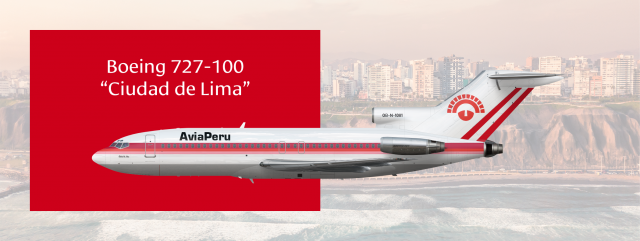
1970s: Inception and early expansion
- Owner: Avelo (View all images and albums)
- Uploaded: Feb 17 2020 06:16 PM
- Views: 1,255
- Album Aviaperú

The history of Aviaperú dates back to 1960, when the Peruvian Army established Servicio Aéreo de Transporte Comercial (SATCO) to operate domestic air and freight services within Peru; its international counterpart, Aerolíneas Peruanas, S.A. (APSA), was a privately-owned airline which operated from 1956 until its bankruptcy in 1971. After the demise of APSA, leftist dictator Juan Velasco Alvarado restructured SATCO into a new civilian company under the name Aerovías Nacionales del Perú (Aviaperú) on 22 May 1973. Initial equipment was a trio of Fokker F28-1000s which began domestic Lima-Cuzco services in October. An ex-Eastern Air Lines Boeing 727 joined the fleet in May 1974, which was then supplemented by a pair of Fokker F27-600s that were ordered for delivery in 1975.
The real prize, however, was clearly to recreate APSA's old long-haul network, and to that end a pair of ex-Viasa DC-8-54s were acquired in July 1974. The acquisition of these planes enabled the start of international service to Buenos Aires via Santiago (Chile) at the end of the month, with the all-important route to Miami starting thereafter. In 1975 Aviaperú was advertising its capability to transport passengers to Machu Picchu as "The world's newest...and perhaps oldest airline."
Almost immediately, Aviaperú encountered financial problems of its own due to an existential issue that would linger for a long time—competition from US airlines, especially Braniff International. Whilst Aviaperú operated only a single daily service to Miami, Braniff operated a whopping 34 weekly flights. The Peruvian military government had a long-standing beef with multinational companies operating in Peru and in February 1975 ordered Braniff to cut its frequencies to no more than sixteen weekly flights. General Rolando Gilardi Rodriguez, the Peruvian Minister of Aeronautics, responded with a public threat to prevent any US airline from flying into Peru if Aviaperú flights to the US are suspended.
General Gilardi said: “We will not permit ourselves to be submitted to this type of colonialist pressure.”
Negotiations involved offering Aviaperú to sell Braniff tickets at a cost for it to sell at a profit as well as access to its computerised sales system. Both of these offers were rejected. On the Peruvian side, the US State Department refused Aviaperú the routes and landing rights it wanted. The stalemate was not resolved and Braniff was forced to cut back its services. As this did not cut to the core of the issue, Braniff simply revamped its schedule to offer more non-stop flights on the route and increase capacity.
As a Braniff executive said: “We are in the middle. We don't like the cutbacks here, but we can live with them, Actually, we don't care how many routes or frequencies the Peruvians get to the United States because we are confident of our ability to get the traffic.”
After the demise of Braniff, Eastern and then American Airlines picked up the void left by their predecessor, and this problem would continue to haunt Aviaperú for years to come.
Nevertheless, the network grew quickly with the addition of services to Bogotá, Caracas, Guayaquil, La Paz, Mexico City, Panama City, Quito, Rio de Janeiro, and São Paulo. The fleet was augmented with a leased KLM DC-8 in 1975 and then a complete rollover of the DC-8s in July 1976 when all three aircraft were replaced by three DC-8-51s leased from Air Jamaica.
Despite issues competing with US airlines, by 1978 Aviaperú was serving not just Miami, but also Los Angeles (since 1975) and New York (since 1977). An additional ex-Lufthansa 727 was added in 1978, as well as a DC-8 freighter.
Registration: OB-N-1081
Aircraft name: Ciudad de Lima

 Sign In
Sign In Create Account
Create Account

















